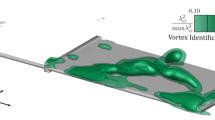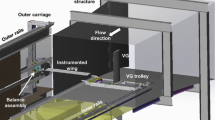Abstract
Extensive measurements were conducted in an incompressible turbulent flow around the wing-body junction formed by a 3∶2 semi-elliptic nose/NACA 0020 tail section and a flat plate. Mean and fluctuating velocity measurements were performed adjacent to the wing and up to 11.56 chord lengths downstream. The appendage far wake region was subjected to an adverse pressure gradient. The authors' results show that the characteristic horseshoe vortex flow structure is elliptically shaped, with ∂ (W)/∂Y forming the primary component of the streamwise vorticity. The streamwise development of the flow distortions and vorticity distributions is highly dependent on the geometry-induced pressure gradients and resulting flow skewing directions.
The primary goal of this research was to determine the effects of the approach boundary layer characteristics on the junction flow. To accomplish this goal, the authors' results were compared to several other junction flow data sets obtained using the same body shape. The trailing vortex leg flow structure was found to scale on T. A parameter known as the momentum deficit factor (MDF = (Re T)2 (θ/T)) was found to correlate the observed trends in mean flow distortion magnitudes and vorticity distribution. Changes in δ/T were seen to affect the distribution of u′, with lower ratios producing well defined local turbulence maxima. Increased thinning of the boundary layer near the appendage was also observed for small values of δ/T.
Similar content being viewed by others
Abbreviations
- C :
-
chord length of appendage
- C f :
-
skin friction coefficient, τ w/0.5 (ϱ) (U ref)2
- D :
-
cylinder diameter
- G, k :
-
coefficients used in Eq. (1)
- h :
-
helicity density, V · Ω
- H :
-
boundary layer shape factor, δ */θ
- MDF :
-
momentum deficit factor, (Re T)2 (θ/T)
- Re ( ) :
-
Reynolds number based on ( )
- T :
-
maximum thickness of appendage
- u′, v′, w′ :
-
root mean square of X, Y, Z velocity fluctuations
- \( - \overline {u\upsilon } , - \overline {uw} \) :
-
ttime-mean Reynolds stresses
- U,V,W :
-
time-mean velocity components in X, Y, Z directions
- U E :
-
local edge velocity
- U ref :
-
reference velocity
- U + :
-
velocity non-dimensionalized by the friction velocity, U/((τ w/ϱ)0.5)
- X :
-
streamwise direction
- X s :
-
location of primary separation (saddle point)
- X v :
-
location of secondary separation (vortex position)
- Y :
-
direction normal to X and Z
- Y + :
-
Y coordinate expressed in wall units, Y(τ wϱ)0.5/gm
- Z :
-
transverse, or spanwise direction
- δ :
-
boundary layer thickness, defined by U/U E = 0.995
- δ * :
-
boundary layer displacement thickness
- θ :
-
boundary layer momentum thickness
- μ :
-
coefficient of viscosity of air
- ϱ :
-
density of air
- τ w :
-
local wall shear stress in freestream direction
- Ω x :
-
component of vorticity in the X direction
- Subscript TC :
-
quantity presented in tunnel coordinate system
References
Agui, J.; Andreopoulos, J. 1991: Near wall vorticity flux dynamics in a three dimensional boundary layer with separation. AIAA Paper 91-0733
Ailinger, K. G.; Simpson, R. L. 1990: Measurements of surface shear stresses under a three-dimensional turbulent boundary layer using oil-flow interferometry. VPI Technical Report No. VPI-AOE-173, VPI & SU, Blacksburg, VA, 24061 (available from DTIC)
Baker, C. J. 1985: The position of points of maximum and minimum shear stress upstream of cylinders mounted normal to flat plates. J. of Wind Eng. and Industrial Aero. 18, 263–274
Baker, C. J. 1980: The turbulent horseshoe vortex. J. of Wind Eng. and Industrial Aero. 6, 9–23
Belik, L. 1973: The secondary flow about circular cylinders mounted normal to a flat plate. Aero. Quarterly 24, 47–54
Cutler, A. D.; Bradshaw, P. 1986: The interaction between a strong longitudinal vortex and a turbulent boundary layer. AIAA Paper 86-1071
Devenport, W. J.; Agarwal, N. K.; Dewitz, M. B.; Simpson, R. L.; Poddar, K. 1990: Effects of a fillet on the flow past a wing-body junction. AIAA J. 28, 2017–2024
Devenport, W. J.; Simpson, R. L. 1990 a: Time-dependent and timeaveraged turbulence structure near the nose of a wing-body junction. J. of Fluid Mech. 210, 23–55
Devenport, W. J.; Simpson, R. L. 1990 b: An experimental investigation of the flow past an idealized wing-body junction: preliminary data report v. 5. VPI Technical Report No. VPI-AOE-172, VPI & SU, Blacksburg, VA, 24061 (available from DTIC)
Dickinson, S. C. 1986 a: An experimental investigation of appendageflat plate junction flow, vol. 1: description. DTNSRDC-86/051
Dickinson, S. C. 1986b: An experimental investigation of appendage-flat plate junction flow, vol. 2: elliptical nose appendage data base. DTNSRDC-86/052
Fleming, J. L.; Simpson, R. L.; Devenport, W. J. 1991: An experimental study of a turbulent wing-body junction and wake flow. VPI Technical Report No. VPI-AOE-179, VPI & SU, Blacksburg, VA, 24061 (available from DTIC)
Hussain, A. 1986: Coherent structures and turbulence. J. of Fluid Mech. 173, 303–356
Johnston, J. P. 1960: On the three-dimensional turbulent boundary layer generated by secondary flow. J. of Basic Engineering 82, 233–248
Kim, S.; Walker, D. A.; Simpson, R. L. 1991: Observation and measurements of flow structures in the stagnation region of a wing-body junction, VPI Technical Report No. VPI-E-91-20, VPI & SU, Blacksburg, VA, 24061 (submitted to DTIC)
Kubendran, L. R.; McMahon, H. M.; Hubbartt, J. E. 1986: Turbulent flow around a wing/fuselage-type juncture. AIAA J. 24, No. 9, 1447–1452
McMahon, H. M.; Merati, P.; Yoo, K. M. 1987: Mean velocities and Reynolds stresses in the juncture flow and in the shear layer downstream of an appendage. GITAER 87–4, Georgia Institute of Technology, Atlanta, GA, 30332
Mehta, R. D. Dec. 1984: Effect of wing nose shape on the flow in a wing/body junction. The Aero. J. of the Royal Aero. Soc., 456–460
Miller, J. A. 1976: A simple linearized hot-wire anemometer. J. of Fluids Eng. 98, 550–557
Moffat, R. J. 1982: Contributions to the theory of single-sample uncertainty analysis. J. of Fluids Eng. 104, 250–260
Moore, J.; Forlini, T. J. 1984: A horseshoe vortex in a duct. J. of Gas Turbines and Power 106, 668–676
Ölçmen, S. M.; Simpson, R. L. 1990: An experimental study of a three-dimensional pressure-driven turbulent boundary layer. VPI Technical Report No. VPI-AOE-178, VPI & SU, Blacksburg, VA, 24061 (available from DTIC)
Pauley, W. R.; Eaton, J. K. 1989: Boundary layer turbulence structure in the presence of embedded streamwise vortex pairs. Seventh Symposium on Turbulent Shear Flows, Stanford University, Stanford, CA
Rife, M.; Devenport, W. J.; Simpson, R. L. 1991: An experimental study of the relationship between velocity and pressure fluctuations in a wing-body junction. VPI Technical Report No. VPI-AOE-188, VPI & SU, Blacksburg, VA, 24061 (available from DTIC)
Rood, E. P. 1984: Experimental investigation of the turbulent large scale temporal flow in the wing-body junction. Ph.D. Dissertation, The Catholic University of America, Washington D.C.
Shabaka, I. M. M. A.; Bradshaw, P. 1981: Turbulent flow measurements in an idealized wing/body junction. AIAA J. 19, No. 2, 131–132
Shin, J. 1989: Effective methods of controlling a junction vortex system in an incompressible, three-dimensional, turbulent flow. Ph.D. Dissertation, Virginia Polytechnic Institute and SU, Blacksburg, VA, 24061
Shizawa, T.; Eaton, J. K. 1990: Interaction of an embedded longitudinal vortex with an attached, three-dimensional, turbulent boundary layer. Report No. MD-56, Thermosciences Division, ME Dept, Stanford University, Stanford, CA
Shizawa, T.; Eaton, J. K. 1992: Interaction of a longitudinal vortex with a three-dimensional turbulent boundary layer. AIAA J. 30, No. 5, 1180–1181
Simpson, R. L.; Heizer, K. W.; Nasburg, R. E. 1979: Performance of a simple linearized hot-wire anemometer. J. of Fluids Eng. 101, 381–382
Spalding, D. B. 1961: Conference internal developments in heat transfer. ASME, Boulder, CO, Part II, 439–446
Westphal, R. V.; Eaton, J. K.; Pauley, W. R. 1985: Interaction between a vortex and a turbulent boundary-layer in a streamwise pressure gradient. Proceedings of 5th Symposium on Turb. Shear Flows, Cornell University, Session 7, 1–8
Wood, D. H.; Westphal, R. V. 1992: Mesurements of the flow around a lifting-wing/body junction. AIAA J. 30, No. 1, 6–12
Author information
Authors and Affiliations
Rights and permissions
About this article
Cite this article
Fleming, J.L., Simpson, R.L., Cowling, J.E. et al. An experimental study of a turbulent wing-body junction and wake flow. Experiments in Fluids 14, 366–378 (1993). https://doi.org/10.1007/BF00189496
Received:
Issue Date:
DOI: https://doi.org/10.1007/BF00189496




